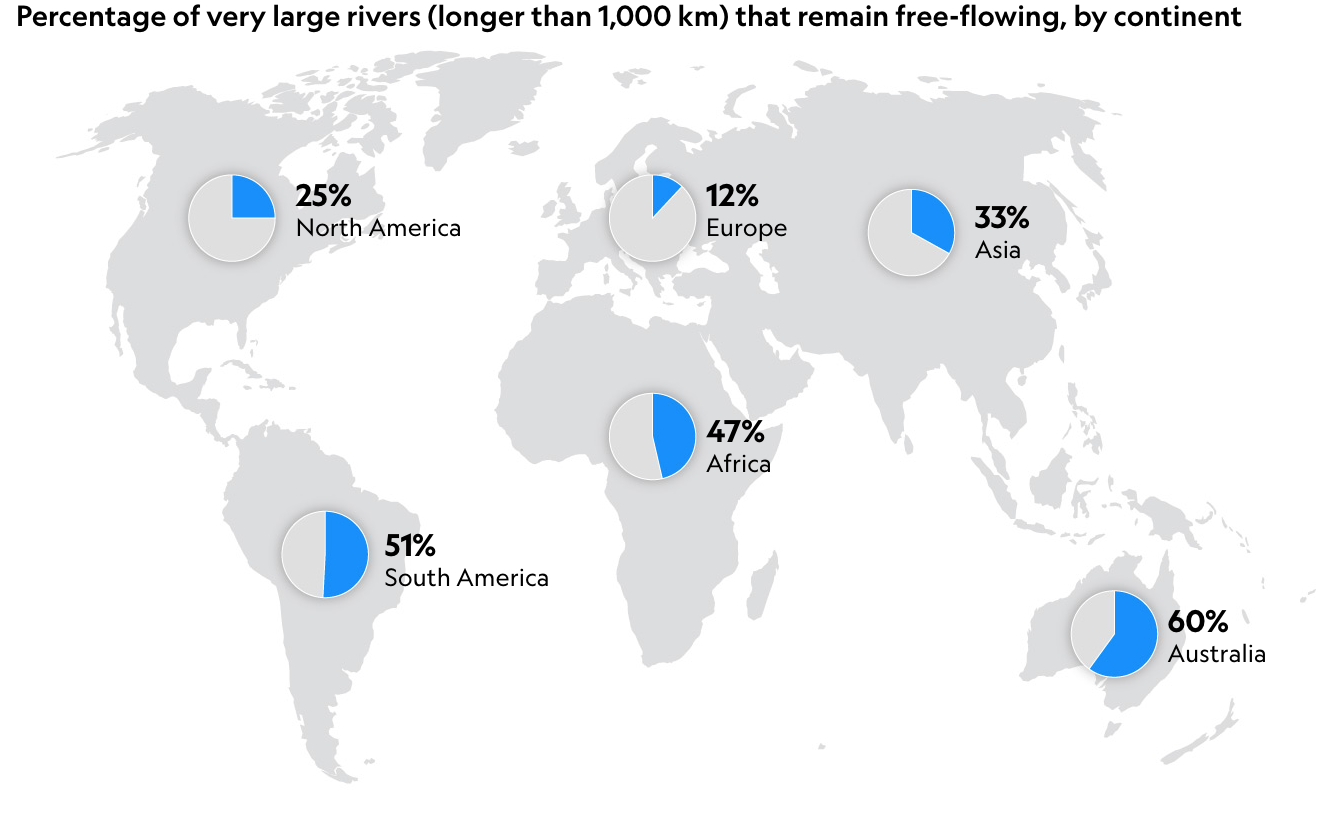
Source: National Geographic
by Yoel Fessahaye
The largest-ever study on global hydrology has discovered that only 37% of the longest rivers (longer than 600 miles) remain free-flowing and 23% flow uninterrupted to the ocean. As National Geographic explains, rivers are the lifeblood of our planet — they provide food and water for hundreds of millions of people, deliver sediments crucial to agriculture, mitigate the impact of floods and droughts, and sustain a wealth of biodiversity. Disruptions to their flow threaten the ecosystem services that both people and wildlife depend on.
Over the period of a decade, the team of 34 international researchers behind the Nature study used satellite imagery and other data to map 7.5 million miles of rivers worldwide.
- According to Science Magazine, the scientists especially focused on the 246 longest rivers encompassing our planet because of their huge ecological impact. Their findings revealed that just 90 (37%) of those rivers are still free-flowing.
- The study points to dams and reservoirs as the main disruptors, although water extraction and sediment trapping also hinder flow in many rivers around the world. There are currently 60,000 large dams around the world with 3,700 more planned or under construction mainly for energy purposes. Even though hydroelectric dams are a renewable energy source, they are far from green. Hydroelectric developments flood pristine habitats and displace millions of people and wildlife.
More so, as aquatic ecologist and creative director of the World Fish Migration Foundation Herman Wanningen points out,
“When a dam is put in, the free-flowing river suddenly becomes a stagnant reservoir, the natural habitat disappears, and with it the fish.” Examples include:
- Rivers like the Columbia in the US — once home to the largest salmon runs in the world — saw fish stocks disappear after they were dammed because migrating fish could not reach crucial spawning grounds.
- Internationally, hydroelectric dams on the Yangtze River led to the extinction of the Chinese Paddlefish, one of the world’s largest freshwater fish.
- Meanwhile, excessive water extraction in Australia’s Murray-Darling river basin caused the death of 1 million fish, including the critically endangered Murray cod.
The most important places for freshwater species are now limited to free-flowing rivers in the remote and inaccessible regions of the Arctic, the Amazon and the Congo Basins. But advancements in engineering technology are also threatening these large rivers and the ecosystems they maintain — in fact, there are plans for up to 500 dams to be built across the world’s largest river basin, the Amazon.
While hydropower development is continuing unabated in some parts of the world, countries like China, Kosovo and the United States are listening to activists and limiting the development of new dams. The United States, which has more than 80,000 dams of all sizes, has been taking down dams and restoring rivers. So far, nearly 1,500 American dams have been removed and several fish species have returned to the newly restored rivers. Across the pond, similar projects are underway, including an initiative called “Dam Removal Europe,” which is working to remove the 30,000 old or obsolete dams scattered across the continent’s rivers.
Why This Matters: This study is the most comprehensive of its kind and it provides a ready source of data for countries working to meet local and international sustainability goals, which include the restoration and protection of freshwater systems. It also provides further evidence for why countries worldwide should choose solar and wind power for their growing energy needs as the flow of our rivers is critical to maintaining global biodiversity and our way of life. Lastly, it is credible proof that activists can use to inform governments and organizations of the importance of free-flowing rivers and the repercussions of man-made disruptions.
May 14, 2019 » damns, hydroelectric, rivers

